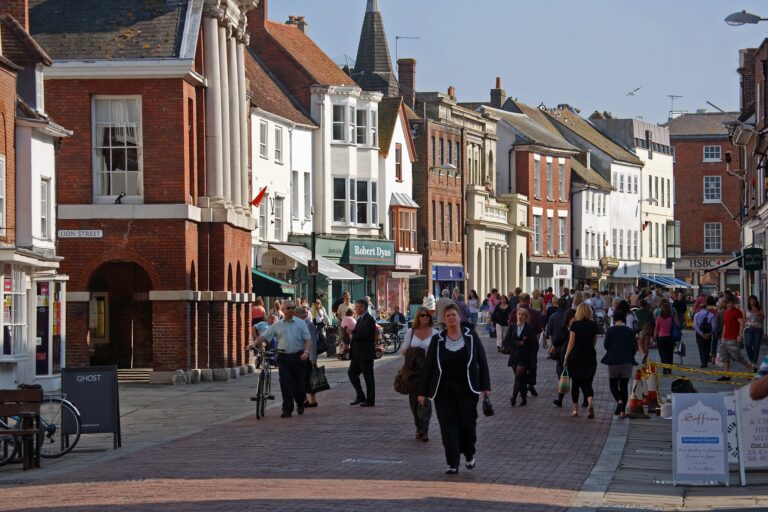- Footfall rose marginally by +0.9% from July to August in all UK retail destinations led by a +2.1% rise in shopping centre footfall followed by retail parks (+2%) whereas activity in high streets declined by -0.1%.
- Compared to 2023 levels, footfall in UK retail destinations rose marginally by +0.1% in August driven by a +3.3% rise in retail park activity. High streets (-0.3%) and shopping centres (-1.8%) experienced modest declines in activity.
- Weekend footfall rose by +1.2% from July to August whereas weekday activity declined by -0.8%. The decline in weekday footfall could be attributed to many people deciding to vacation abroad this year and aligns with pre-pandemic trends.
- The back-to-school rush and mandated office returns in September could provide retailers with a boost in weekday footfall providing them with an opportunity to maximise sales especially as we head into the final, yet busiest, part of the year.
In a month typically dominated by the great summer getaway, retail footfall rose by +0.9% from the month before in UK’s retail destinations, according to MRI Software.
Jenni Matthews, marketing and insights director at the company, said: “This growth was primarily driven by rises in retail parks (+2%) and shopping centres (+2.1%) whereas high streets witnessed a marginal decline of -0.1% likely boosted by a rebound in activity during the third week following the ongoing disorder which occurred in many parts of the UK.”
Comparing against 2023 levels, she said footfall rose ever so slightly by +0.1% in all UK retail destinations boosted by activity in retail parks rising by +3.3% whereas shopping centres and high streets witnessed declines of -1.8% and -0.3%, respectively. “This aligns with historical trends witnessed pre-pandemic where high streets and shopping centres would experience a lull in footfall as many people took vacations abroad in August and it appears this trend is re-emerging signalling the return to normalcy which has been consistent throughout the year.”
Matthews said that as anticipated, the month started on a weak note with the first two weeks averaging a decline of -2.2% week-on-week. This was likely influenced by the school summer holidays and many people choosing to travel abroad, combined with protests and riots impacting much of the UK with high streets feeling the full force.
“The latter part of the month witnessed an uplift in activity as normality resumed however factors likely contributing to a bounce back in high street footfall probably came in the form of warmer weather and music events in certain parts of the UK, including the final leg of Taylor Swift’s Eras Tour, which would have positively impacted activity in towns and cities. This was particularly noticeable in London locations where footfall spiked by +8% year on year in the final week of the month.
“Unsurprisingly, retail parks continued to demonstrate resilience with footfall rising by +2% month-on-month and +3.3% year-on-year. This is likely to be due to the fact that many are located out of town making them easily accessible by car, and also offer a whole host of retail, leisure and hospitality amenities which is perfect for keeping families entertained during the school holidays.”
MRI found that the true impact of overseas holidays was evident with weekday footfall in all UK retail destinations down by -0.8% year on year whereas weekend footfall rose by +1.2%. “This may well mark the return of holiday goers and events in towns and cities driving footfall as UK high streets experienced a +2.7% rise in weekend footfall year on year.”
As preparations for Autum get underway, MRI Software’s weekly “Insights from the Inside” poll* revealed that 37% of retailers have seen social channels such as TikTok and Instagram support a boost in their in-store sales, which highlights the positive impact on using such methods to drive in-store footfall. “Retailers can leverage this platform to promote new in-store arrivals and in-store promotions to gain traction as we head into the final, yet busiest, part of the year, said Matthews.
“The back-to-school rush will also be prominent in the coming days however the greatest impact for retail destinations in September could be the mandated return to office which is due to be enforced by many businesses nationwide. This shift may lead to an uplift in weekday footfall as more people return to offices on a regular basis and offers retailers a chance to capitalise by preparing accordingly in terms of staffing and asset maintenance to ensure a seamless experience for the customer. Consumer confidence, according to GFK, remained stable in August however the forecast for personal finances over the next 12 months rose by three points which signals optimism for the sector as we head into the busiest period of the year.”
*A weekly survey of over 700 store managers which provides insights from the shop floor around how external factors and consumer behaviour are impacting both footfall and spending.


